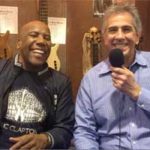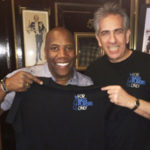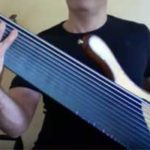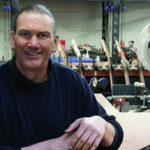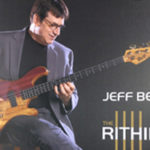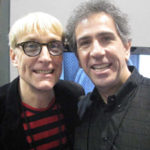Decades-long first-call sideman gives FBPO all the details about (finally!) stepping out on his own!
Exclusive interview with FBPO’s Jon Liebman
April 7, 2014
Nathan East is considered a legend in the bass world. Born in Philadelphia and raised in San Diego, Nathan eventually became a mainstay in the L.A. studio scene. He has recorded with Whitney Houston, Madonna, Elton John, Beyoncé, Michael Jackson, Lionel Richie, Stevie Wonder, Andrea Bocelli, Barbra Streisand, Quincy Jones and countless others. He has also done extensive tours with Kenny Loggins, Al Jarreau, Herbie Hancock, Toto, Phil Collins and Eric Clapton.
East is a founding member of contemporary jazz supergroup Fourplay, with Bob James, Lee Ritenour and Harvey Mason. To date, the band has earned six Grammy nominations. Nathan was also named “Most Valuable Player” in the bass category of the International Rock Awards and is a three-time recipient of the National Smooth Jazz Award for Bassist of the Year. The National Academy of Recording Arts & Sciences (NARAS) has awarded Nathan “Emeritus” status for winning the most consecutive years as MVP Bassist. East was also awarded a Congressional Record in recognition of his talents and services to the global music community.
Most recently, Nathan won a Grammy award for “Record of the Year” with the group Daft Punk for their hit single, “Get Lucky.” FBPO’s Jon Liebman caught up with Nathan to talk about his brand new debut solo release, simply titled Nathan East.
FBPO: You are a busy guy these days!
NE: Oh man! I don’t even go to sleep any more!
FBPO: Congratulations on the Grammys and the new album and everything else you’ve got going on.
NE: Thanks very much. I’m feeling quite blessed and loving my life. So far, 2014 has proven to be quite an exciting year.
FBPO: It sure is off to a good start for you!
NE: It’s off to a great start!
FBPO: I was looking over the first interview you did for us on ForBassPlayersOnly.com and, toward the end, when I asked about your future plans, you said you were talking to the Yamaha people about doing a solo CD. And, lo and behold, here we are!
NE: You know, it’s funny because I went back and took a peak at that article the other day and it was just like, Wait a second! The time just goes by so quickly!
FBPO: What was the message you wanted to get across with this solo release?
NE: Well, in theory, it’s a solo record, but I can’t really use the term “solo” because it’s a collaboration with many of my friends that I’ve made music with over the past three decades. I just wanted to celebrate some of my favorite music and compile it on a disc that I would be proud of, that music lovers might want to hear.
FBPO: How did you decide what tunes to include on the record?
NE: Chris Gero, my co-producer, and I, about a year ago, went and bought the biggest whiteboard we could find and we just started throwing out ideas. We wrote down as many songs as we could, that we liked, and just started throwing out ideas for songs.
FBPO: Was there something all these songs had in common, or was it just anything and everything that you liked and you thought would be good?
NE: I think it was just anything and everything. Don’t think about it too much. Don’t get too picky. Just put ‘em out there! If we like it, it goes on the list.
FBPO: I’m sure there were more songs on the list than the ones that made the final cut. How did the chosen ones get chosen?
NE: Yeah, the list included about fifty songs. Out of those we actually recorded twenty-six. The final thirteen ended up being a tricky choice, but we wanted to have a good balance, a good flow to the record and some of the material I thought just had to go on.
FBPO: I would think with your pedigree and experience, you could have had just about anyone you wanted on the record. How did you decide which musicians to use?
NE: Well, I have a lot of friends to choose from and it was one of those situations where I had my list of top choices. We were talking about, “Okay, who’s your first choice, second choice,” etc. As it turns out, all my first choices were available.
FBPO: The first tune on the recording, “101 Eastbound,” is an old Fourplay tune.
NE: Yes, it’s definitely one of our Fourplay chestnuts.
FBPO: It doesn’t sound quite like the original.
 NE: Yeah, it’s just a little bit different. You know, we’ve been playing that song now for more than twenty years, so from time to time, just to do something different, I start the song with this Brazilian-flavored introduction before we get into the groove. One of my friends heard my intro and said, “You should record that!” I thought that wasn’t a bad idea, so that was one of the approaches I took to the song. I thought, we’ve got the Fourplay version, so let’s see if we can come up with something with a little different twist on it.
NE: Yeah, it’s just a little bit different. You know, we’ve been playing that song now for more than twenty years, so from time to time, just to do something different, I start the song with this Brazilian-flavored introduction before we get into the groove. One of my friends heard my intro and said, “You should record that!” I thought that wasn’t a bad idea, so that was one of the approaches I took to the song. I thought, we’ve got the Fourplay version, so let’s see if we can come up with something with a little different twist on it.
FBPO: It sounds good and it feels good.
NE: Thanks. The number one criterion for every song is that it has to feel good.
FBPO: “Sir Duke.” I wish I could have seen my face and the reaction I had when I was listening to it for the first time. You take some liberties with the harmony. I know my eyes got real big, that much I know! But what was that all about? It’s very cool and a real surprise!
NE: [Laughs] Well, thanks so much. First of all, you can’t really reinvent Stevie Wonder because he’s the wheel. He’s the man we’ve all been drawing from forever. At the same time you want to do something different and I thought it would just be fun when we got to the chorus section at least to play around with different modulations and keys, so that’s kind of what we came up with in the studio. And then my buddy Jeff Babko, for in the intro, said, “Well, what about these cool chords?” and I said, “Yes, yes, yes!” A little re-harmonization. It really turned out to be a fun arrangement. We captured all of the great elements that Stevie’s version has and included a little bit of ours as well.
FBPO: Speaking of Stevie, you got the man himself on another cut, his own tune, “Overjoyed,” playing harmonica. How did that come to be?
NE: Right! That, for me, is just a blessing, to get Stevie Wonder to play on his own song! We all love his harmonica playing, but that was just a little bit of a fluke. We were at a rehearsal at Carnegie Hall for Sting’s “Rainforest Foundation” benefit and there was a little break and some down time. While I was waiting, I started fooling around with the chord changes to “Overjoyed” on the bass, trying to come up with a little version of it. I was just sitting there, trying to work it out and the next thing I know I hear a harmonica playing. I didn’t even know Stevie was in the building. At this point, the harmonica’s playing along with me and I’m trying to work out the arrangement on the spot. I stumbled my way through it and when we finished, there were James Taylor, Bonnie Raitt, Sting, Elton John, all standing there applauding! Stevie said, “If you ever record that, call me to play on it.” How do you pass up an offer like that?!
 FBPO: Another surprise was “Moondance.” You’ve got Michael McDonald, another great choice. You start with just the bass for the intro, then bass and voice. Then you hit the listener right between the eyes with this blaring big band that comes out of nowhere!
FBPO: Another surprise was “Moondance.” You’ve got Michael McDonald, another great choice. You start with just the bass for the intro, then bass and voice. Then you hit the listener right between the eyes with this blaring big band that comes out of nowhere!
NE: Yes. I’ve got to give credit to Chris Gero for that vision. We called in one of my favorite musicians and arrangers, Tom Scott, to write the arrangement. Chris’ vision was to start the song with just bass and voice doing the tune where nobody would really know what’s going on or what’s going to happen and then, all of the sudden, like you said, right between the eyes, this big band comes in and just hits you and takes you on a ride!
FBPO: A fun ride, indeed!
NE: “Moondance” is a song I used to play when I was 14 years old, in one of my first bands. I used to sing it in the band. Before we even recorded a note of this project, Michael McDonald said, “I’m in. Let me know.” And as you can hear, he just rips it!
FBPO: You’ve got another Michael McDonald tune on the record, “I Can Let Go Now.”
NE: Yes, that’s one of my favorite Michael McDonald compositions. “I Can Let Go Now” is one of those songs that, when I hear him do it in concert, I’m just in a puddle of tears! [Laughs]. I think it affects everybody the same way. Sara Bareilles heard it and she just came in and sang it like she wrote it, on the first take. She just did an amazing job on the song for which I will be forever grateful.
FBPO: Not only are there some beautiful horn arrangements on the album, but there are some exquisite string arrangements. Who’s Lendell Black?
NE: He’s an arranger who lives in Nashville. I hadn’t heard of Lendell until our engineer, Bryan Lennox, came one day and said, you know, there’s this arranger that I just worked with and he’s really, really good. So we sat down with Lendell Black and he came up with some beautiful arrangements and did a great job. I absolutely love working with him.
FBPO: Then, for a complete change of pace, is your song “Daft Funk.”
NE: Right! [Laughs]
FBPO: I like a lot of things about that tune: the call & response and the melodic bass lines. And the “talk box.” I dug it way back in the day, when Peter Frampton and Joe Walsh did it, but this sounds like a modern-day version of that, which really fits the song well.
NE: Oh, thanks. Michael Thompson sent me the demo early on and it had a lot of the elements, like the call & response, and I liked it immediately. He was playing bass on his demo and it had these little sections and I thought it would be fun to kind of write this uplifting, off-the-wall kind of party section. We had Tom Scott play on it and it just turned into a fun piece of music, sort of going retro. I know my buddies Daft Punk went retro last year with “Get Lucky” and that was such a cool spirit and energy, we just said, “You know, this has to be ‘Daft Funk.’”
FBPO: I wasn’t sure whether or not I was going to ask you, but something is really bugging me. For about three decades now, you’ve been playing for some of the biggest names in the music world, including Eric Clapton and Phil Collins and Toto and Fourplay. Now, nothing against Daft Punk, I like that band, but I’m hearing a lot of people saying, “Hey, the Daft Punk guy came out with a solo record.” And it bugs me!
NE: [Big laugh!] Everybody’s been asking me the same question because it’s almost like I haven’t done anything else prior to working with them.
FBPO: Exactly!
 NE: I love it! I think, basically, since Nathan East isn’t a household name, folks sometimes need an association for validation. USA Today’s headline read, “Daft Punk’s Nathan East heads in his own direction” [Laughs]. I got a kick out of it and it just goes to show you, whatever creates the biggest buzz line, that’s what they need to use so they can go to their editors and say, “Okay,we have a story.”
NE: I love it! I think, basically, since Nathan East isn’t a household name, folks sometimes need an association for validation. USA Today’s headline read, “Daft Punk’s Nathan East heads in his own direction” [Laughs]. I got a kick out of it and it just goes to show you, whatever creates the biggest buzz line, that’s what they need to use so they can go to their editors and say, “Okay,we have a story.”
FBPO: [Smiling] Okay. I’m glad you’re laughing, because it still bothers me!
NE: [Laughing] Michael Thompson and I went with the title “Daft Funk” as an ode and a little tribute, but definitely tongue-in-cheek, as well.
FBPO: How about “SeveNate,” the Chuck Loeb tune? I like the title, too.
NE: Chuck’s birthday is December 7th and mine is December 8th. We usually celebrate right at midnight, at the “seven/eight,” right in the middle of both birthdays. So Chuck, being the genius songwriter that he is, took that spirit and put the song together for me.
FBPO: There’s some beautiful acoustic guitar playing on that song.
NE: Oh, man, I love the way it came out! And Chuck is such a wonderful musician and friend and we really love having him in the band (Fourplay) and he’s my “Fairy Godbrother.” That’s what we call each other!
FBPO: “I Can’t Find My Way Home” is a beautiful arrangement.
NE: Oh, thank you. I love that song.
FBPO: I don’t want to bring you down, but I’ve got to mention Ricky Lawson. He played so beautifully throughout the whole album. That was pretty close to the end for him, wasn’t it?
NE: Yes, pretty close. Sometimes, it’s so emotional for me. Every time I listen to the record, I feel his spirit and there’s a big hole in my heart in knowing that Ricky is not around for us to go out and play it.
FBPO: Tell me something about Ricky Lawson.
NE: Apart from being one of the world’s greatest drummers, he was my “Brother from another mother.” He was one of the most caring, considerate and kind individuals that I think you could ever meet in your life. That’s what I really miss most of all because he would just call me (from) wherever he was in the world to say, “I love you and I’m just checkin’ in with you.” Whenever I’d go out of town, he’d say, “Nate, do you need me to go check on the family? If they need anything, just call me.” Really, one of my dearest friends in this life. We’ve known each other for thirty years and we’ve played together and toured together. It was a very, very sad loss when he passed away, so we try to just keep his memory alive with this record and all the other good things he did while he was here. I dedicate my album to him.
 FBPO: He did a beautiful job on the whole album. On “Can’t Find My Way Home,” I still found myself waiting for that crash cymbal that you hear on the original!
FBPO: He did a beautiful job on the whole album. On “Can’t Find My Way Home,” I still found myself waiting for that crash cymbal that you hear on the original!
NE: Right [Laughs]. We were just kind of in the studio, just winging it as we went along. It was like, “Let’s do this. Hey, that sounds good.” You know.
FBPO: I’m sure a lot of people don’t know, or maybe they’re starting to know, that you are also a very accomplished upright bass player. “Moodswing,” for example and one or two other tunes have gorgeous upright bass playing and soloing! They remind me of the interview I did with Bert Turezky last year, your old bass teacher. He talked about you a little bit.
NE: Yes, Bert, my professor, mentor and friend.
FBPO: I had known of him for so many years and I finally met him at a conference for the International Society of Bassists at Eastman School of Music in Rochester, New York, and his personality was not at all what I had imagined, not what I was expecting!
NE: Oh, that’s too funny! I know. He’s a hoot. I love him!
FBPO: Bob James sounds great on “Moodswing” too. Another nice addition to the album.
NE: “Moodswing” is a Bob James composition and he describes it as a musical representation of our friendship. I love him dearly and we’re actually exploring the possibility of doing a duet record together, piano and acoustic bass, which would be so much fun!

Todd Gray Photography
FBPO: Right. Speaking of piano players, you know I’ve got to ask you about “Yesterday.” That had to have been such a special experience for you, playing with your son, Noah, who is, what, 13?
NE: He’s 13 years old and you’re absolutely right, just a very special time, a very special memory and I’m just so thankful we captured it on this record. Noah stopped by the studio one afternoon when Chris and I were in pre-production. He had just come from piano lessons and Chris said, “Oh, what have you been working on?” So he sat down and played “Yesterday” and Chris says, “That has to go on the record!” It wasn’t even Daddy getting his son on the album. It was inspiring, to say the least.
FBPO: I had the pleasure of meeting Noah once or twice. I know you took him to Bass Player Live! one year. He is musically mature beyond his years.
NE: I think I have to agree with you, not just because I’m Dad. I discovered at a very early age that he has perfect pitch. He was about 5. I could go over to the piano and hit any note or any group of notes and he would just say, “B flat! A flat! G!” He’s always had an incredible ear and absolutely loves music. You can tell when he plays. You can see it kind of going through his bones. I think what you hear on the record was his first take, too. He went into the studio and he was really prepared. When we hit “Record,” he was right in there and just nailed it.
FBPO: I love the Latin rhythms on “Madiba,” the acoustic piano, the soloing, a little bit of slapping. Tell me about that song.
NE: It’s our tribute to Nelson Mandela and also a song that Chris Gero actually showed me about a year before we even went in, when we were first talking about me doing the record. He was at the piano and he played the bass line and it stuck with me. So we worked on the song and it just seemed to kind of grow. We spent a lot of time on the arrangement so it would really sound like a performance piece. We recorded the track in Los Angeles at Ocean Way Studio and Chris took it back to Nashville and added a choir. Then he got everybody from his office to go into the studio and sing the ending chant line. He recorded it to make it sound like they were in a stadium! He actually turned a studio track into a live concert sounding, epic production and I really love the way it turned out.
 FBPO: It really does sound like a huge production.
FBPO: It really does sound like a huge production.
NE: And the main thing is that it sounds like a festive celebration of Madiba.
FBPO: You have in there some unison bass lines with the piano and great use of the upper range. I particularly like when you sing along with your solo.
NE: Right. A little scatting. Trying to be George Benson! [Laughs]
FBPO: “America the Beautiful.” I’ve got to bring up the obvious reference to Jaco. How much were you thinking of Jaco when you did that song, that anthem?
NE: Well, I mean, how much do you not think of Jaco when you pick up a bass? He was like a blessing and a curse to a lot of us bass players. You can’t escape his spirit. Of course, I was inspired by his version, which I learned, but then I wanted to take it to another level. Chris suggested starting like Jaco but then adding an orchestra and making it epic. Let’s turn it into a new National Anthem that America can embrace.
FBPO: Once again, a beautiful string arrangement.
NE: Yes, thank you. Chris, Lendell and I sat in the studio and really worked out the arrangement. I had my bass out and we just played around with several ideas. Lendell did a great job orchestrating it. Once it was all put together, it was really an emotional experience recording this wonderful anthem with the Nashville Orchestra.
FBPO: How about the Pat Metheny song, “Letter From Home”?
NE: First of all, Pat is a dear friend and also probably one of my favorite musicians. He’s like Stevie Wonder, with a catalog of songs that become soundtracks for your life. I wanted to have something “Metheny” on this record and Chris, again, when we were tossing around song ideas, said, “Hey, what about the song ‘Letter from Home’”? And I said, “I love that!”
The cool thing is I sent our recording to Pat for his approval and he loved it. So, he has given his blessing on my version and, for me, that’s the closest thing to having him on the record. Pat doesn’t usually guest on other records, but we are talking about him possibly writing something for me, so I’m holding out for that.
FBPO: Well, you’ve got a lot of tunes in the hopper, so a follow-up record would certainly not be out of the question, I hope. So why not include that, if possible?
NE: Absolutely! As a matter of fact, we’re more than half-way through the next record already. We have thirteen songs “in the hopper,” like you said and we’re going to try to get right back in and keep the party going.
FBPO: I hope the star power on the follow-up will be comparable to this release. We talked about Bob James, Chuck Loeb, Michael McDonald, Stevie Wonder, your son Noah, Sara Bareilles, the arrangers and Chris Gero, but there are some other big names we haven’t mentioned.
NE: I want to definitely give a shout out to my core rhythm section, with Jeff Babko and Tim Carmen on keyboards, Michael Thompson and of course Ricky Lawson, who I dedicate the album to. Rafael Padilla was my percussionist for the whole record. And then there’s David Paich. When David found out we were in the studio, he just showed up and if David Paich shows up to the studio, you just have to put him on something! So he jumped out and played on about three or four songs. Then Ray Parker, Jr., was so great. He found out I was recording and just called me and said, “It’s gonna be a history maker, so I gotta be on it!”
|
Nathan has endorsed Jon Liebman’s second book,
|
FBPO: You are pretty much a Yamaha guy. Tell me what equipment you used on the record, Yamaha and otherwise.
NE: I used my Yamaha basses: The Nathan East Signature BBNE-2 was the primary bass for all the rhythm tracks. I did a lot of soloing with my TRB 6-string bass. And for the upright bass sound I used my SLB-200 “Silent” Bass. I recorded through my Radial Engineering “Firefly” Tube DI direct box. For amplification I used my TC Electronic “Blacksmith” amp. My regular gauge strings are made by Jim Dunlop and Yamaha.
FBPO: Tell me a little bit more about the “Silent” bass.
NE: The “Silent” Bass is an amazing instrument. I think they’ve done some serious R&D to make this instrument sound a lot like an actual upright bass. And if you mic the fingerboard while you take the direct signal, it’s pretty hard to distinguish the difference between the two. Obviously, it’s easier to carry around. It just folds up into a small gig bag that you put over your shoulder. For practicing purposes, it’s fun because I can just have it in my hotel room, open it up and put it together and sit there and be in the woodshed without disturbing anyone.
FBPO: How long does it take, from the time you remove it from its case until you’re playing it?
NE: Under 60 seconds!
FBPO: You string your 5-string with a high C, instead of a low B.
NE: I strung it like that for “Sir Duke” and I discovered that I really liked it, in contrast to playing the 6-string.
FBPO: So, you don’t normally do that, but only for special occasions?
NE: Yes, not normally, but I’m thinking that I will probably just have one of my 5-strings strung with the high C because it’s really fun for playing the melody and for soloing.
FBPO: That sort of begs the question: Why don’t you just use the 6-string?
NE: I could just use the 6-string, however, the 5-string ends up being actually lighter and, for some reason, I feel a little more free and it’s easier to play without so much real estate and not so many strings. [Laughs]
FBPO: Yeah, it is a beast!
NE: The 6-string gets kind of big and chunky, and heavy to travel with.
 FBPO: How about the U-Bass? That instrument is becoming so popular.
FBPO: How about the U-Bass? That instrument is becoming so popular.
NE: I love my U-Bass! Not only can I easily take it around on tour with me, but it records great as I discovered while working in the studio with Eric Clapton on his latest album.
FBPO: What about effects?
NE: I didn’t really use any effects on the record. Any effects that you hear were created in the studio, by our engineer.
FBPO: Are you going to do any touring to promote the record?
NE: Absolutely! I have a Guitar Center clinic tour scheduled at the moment. See my website for dates. I also have offers in Japan and Europe and it will be fun to put a band together and take this show on the road.
FBPO: Did I read somewhere that you’re working on a J.J. Cale tribute album?
NE: Yes, that’s something I’m working on with Eric Clapton. I’m not exactly sure when it’s scheduled for release, but, another great project to be involved with.
FBPO: Do you have anything else going on or coming up?
NE: Well, the year started with a pretty good musical bang, playing the Grammys with Daft Punk & Friends. I just returned from a tour in Japan, Singapore, Dubai and Bahrain with Eric and it was good to reunite with him and the band. I’m actually going to turn around and head back to Japan with Toto in the spring. And then Fourplay has some touring dates coming up including another trip back to Japan. Of course I will be promoting my new album and have appearances scheduled for The Tonight Show, Tavis Smiley and Sirius XM Radio already.
Nathan’s new CD, Nathan East, is available here:
See our first interview with Nathan, as well as our exclusive FBPO
interview with Bert Turetzky, who is also mentioned here:
[table id=19 /]



